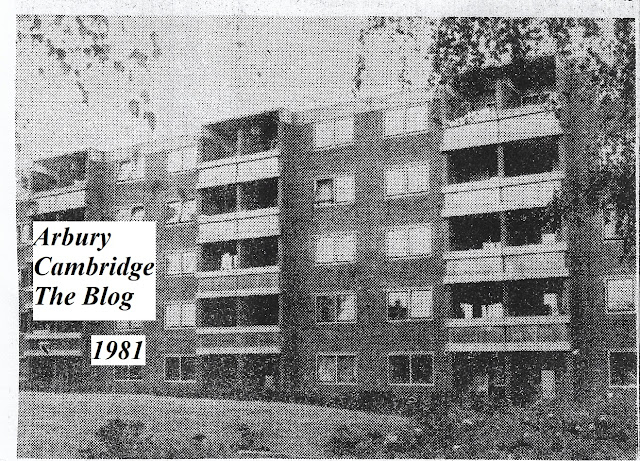
Photograph from Sara Payne's 1981 'Down Your Street' article - the Kingsway Flats. The photograph was taken by the 'Hump' and the seats on the corner of Verulam Way. The seats were let into the low wall, facing the hills and the flats. They were removed sometime around the late 1990s/early 21st century.
Continuing our look at Sara Payne's 1981 Down Your Street article from the Cambridge Weekly News, and our delvings into our own memory banks and the transcripts of the Arbury 1980 project.
Sara Payne spoke to Mr Whitehead, of Tedder Way, who was 'rather an authority on Arbury...'
When Mr Whitehead first came to Arbury in the fifties it was 'a sea of mud in a large, bleak landscape.' There is still something of that bleakness about the approaches to the Kingsway Flats. The flats themselves are quite snug inside with decent sized sitting rooms (residents were bunked up in front of Wimbledon when I was round there last week) but it is the draughty passageways where the wind gets up that are the bone of contention, together with the sign posting of the flats. It is very hard to track down the flats at the back.
Elderly residents confessed to finding it lonely. 'It can be lonely up here,' said Miss Ethel Stubbings, who used to work as a domestic help in the now demolished nurses' home which stood in Queen Anne Terrace. She would have been used to more bustle there.
While the health authority hold a variety of clinics on the ground floor of the Kingsway Flats, there seems to be a great need for a day room for the residents, somewhere where they could meet, have social evenings, play games and find companionship.
Since those days, the Kingsway has lost the block of garages near Carlton Way. Does anybody remember the tennis courts on top, with their wire enclosures? If we remember rightly, there were two, side by side, and the metal supports looked rusty even back in the early 1970s. We never saw anybody playing tennis there!
In 1981, as mentioned above, Kingsway residents told Ms Payne that the layout and signposting of the flat numbers of the complex was causing some confusion. One particular flat was, apparently, particularly hard to find!
Of the roads off Carlton Way, former councillors and mayors were, of course, represented (Alex Wood Road and Brimley Road), Dr Stephen Perse of the Perse School (Perse Way), a Roman reference was provided with Verulam Way (leading to another - St Alban's Road), and Mere Way, which ended Carlton Way.
Dipping into the transcripts of the Arbury 1980 project, we discovered that Roseford Road, which was 'off' Carlton Way before the Kingsway was built, was apparently named after the owner of the ground's niece, Rose Fordham.
'Brimley... there used to be a grocers in the town. I believe he was mayor - Brimley and Wibley' - 'Arbury 1980' transcripts. Some brief 21st Net hopping reveals that Brimley Road was named after Augustine Gutteridge Brimley (1794-1862), 'wholesale grocer, hop and provision merchant' - and Cambridge mayor from 1853 to 1854. Does anybody know of a Wibley link?
As for the reason behind the naming of Carlton Way, well, our memories, the Arbury 1980 transcripts and Ms Payne's article cannot provide the answer. But there is speculation in the last named...
Over the way at the popular Carlton Arms, the licensee, Mr John Salmon, provides a clue as to how Carlton Way got its name. He referred me to the coat of arms of Baron Carleton, a replica of which is hanging in the pub.
'Henry Boyle, the first and only Baron Carleton, lived in Pall Mall. He bequeathed his house there to the Prince of Wales. Baron Carleton was noted for his elegance, said Mr Salmon.
The Carlton Arms, a Whitbread pub, was built in 1959 so Baron Carleton may not have given his name to Carlton Way. Does anybody know?
We could find no enlightenment in the letters which responded to the article in subsequent editions of the Cambridge Weekly News, so we assume nobody did know.
But if anybody out there in the modern day wonderful world of the Web can tell us, we'd be very happy!

.png)




According to Stubbings and Gray, Cambridge Street-names, At CARLTON
ReplyDeleteWay the line of the Roman road is followed exactly; the name is
that of Henry Boyle, first Lord Carlton, who died in 1725, was
MP for Cambridge University 1692–1705 and Chancellor of the
Exchequer in 1701. His coat-of-arms appeared on the inn-sign
of the Carlton Arms until 1996
Excellent - thank you very much indeed. The Carlton Arms opened in 1959, by which time Carlton Way had been in progress for some years, and the brewery had obviously got its information on the origins of its name from the Council. It was not conjecture.
DeleteAugustine? It's funny but I always thought the person Brimley Road was named after would be called Harold or something like that!
ReplyDeleteGreat name, eh? The next stop in our 'Main Streets of Arbury' series is Campkin Road - named after Algernon Sidney Campkin.
Delete